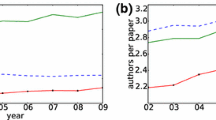Abstract
In this paper we use the DBLP data to investigate the co-author relationship in a real bibliographic network and predict the interactions between co-authors. We analysis the research trend of authors and conferences based on keywords extracted from paper titles. We can understand research fields and change of research trend to find appropriate co-authors and conferences to submit our work. We also find potential co-authors for an existing author in DBLP data by using a variety of similarity measures and a random walk model. It can be useful for building a recommendation system.



Similar content being viewed by others
References
Cha SH (2007) Comprehensive survey on distance/similarity measures between probability density functions. Int J Math Models Methods Appl Sci 1(4):300–307
Deng H, King I, Lyu MR (2008) Formal models for expert finding on DBLP bibliography data. In: Proceedings of the 8th IEEE International Conference on Data Mining (ICDM 2008), December 15–19, Pisa, Italy, pp 163–172
Deza E, Deza M (2006) Dictionary of Distances. North-Holland
Han S, He D, Brusilovsky P, Yue Z (2013) Coauthor prediction for junior researchers. In: Social Computing, Behavioral-Cultural Modeling and Prediction - 6th International Conference, SBP 2013, Washington, DC, USA, April 2-5, 2013. Proceedings, pp 274–283
Jung JJ (2011) Service chain-based business alliance formation in service-oriented architecture. Exp Syst Appl 38(3):2206–2211
Jung JJ (2012) Evolutionary approach for semantic-based query sampling in large-scale information sources. Inf Sci 182(1):30–39
Jung JJ (2013) Contextual synchronization for efficient social collaborations in enterprise computing: a case study on tweetpulse. Concurr Eng-Res Appl 21(3):209–216
Jung JJ (2014) Measuring trustworthiness of information diffusion by risk discovery process in social networking services. Qual Quant 48(3):1325–1336
Ley M (2002) The dblp computer science bibliography: Evolution, research issues, perspectives. In: String Processing and Information Retrieval, 9th International Symposium, SPIRE 2002, Lisbon, Portugal, September 11-13, 2002, Proceedings, pp 1–10
Ley M (2009) Dblp - some lessons learned. PVLDB 2(2):1493–1500
Li J, Xia F, Wang W, Chen Z, Asabere NY, Jiang H (2014) Acrec: a co-authorship based random walk model for academic collaboration recommendation. In: 23rd International World Wide Web Conference, WWW ’14, Seoul, Republic of Korea, April 7-11, 2014, Companion Volume, pp 1209–1214
Pham XH, Jung JJ (2014) Recommendation system based on multilingual entity matching on linked open data. J Intell Fuzzy Syst 27 (2):589–599
Rajaraman A, Ullman JD (2011) Mining of massive datasets. Cambridge University Press, NY, USA
Sun Y, Barber R, Gupta M, Aggarwal CC, Han J (2011) Co-author relationship prediction in heterogeneous bibliographic networks. In: International Conference on Advances in Social Networks Analysis and Mining, ASONAM 2011, Kaohsiung, Taiwan, 25-27 July 2011, pp 121–128
Zaïane OR, Chen J, Goebel R (2007) Mining research communities in bibliographical data. In: Proceedings of the 9th International Workshop on Knowledge Discovery on the Web and 1st International Workshop on Social Networks Analysis, San Jose, CA, USA, August 12-15, 2007, pp 59–76
Acknowledgments
This work was supported by the National Research Foundation of Korea (NRF) grant funded by the Korea government (MSIP) (NRF-2014R1A2A2A05007154). Also, this research was supported by the MSIP (Ministry of Science, ICT&Future Planning), Korea, under the ITRC (Information Technology Research Center) support program (NIPA-2014-H0301-14-1044) supervised by the NIPA (National ICT Industry Promotion Agency).
Author information
Authors and Affiliations
Corresponding author
Rights and permissions
About this article
Cite this article
Jung, J.J. Big Bibliographic Data Analytics by Random Walk Model. Mobile Netw Appl 20, 533–537 (2015). https://doi.org/10.1007/s11036-014-0555-2
Published:
Issue Date:
DOI: https://doi.org/10.1007/s11036-014-0555-2




